Description of vibratory rammers and tips for their use

Before carrying out construction or road works, the process technology provides for preliminary compaction of the soil. This compaction increases the soil's resistance to moisture penetration and prevents soil erosion, as well as improves the load-bearing properties of the surface for foundation or roadway equipment. With the help of vibratory rammers, you can quickly and efficiently compact any loose soil, preparing it for further work.
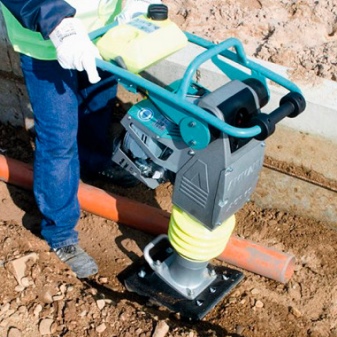
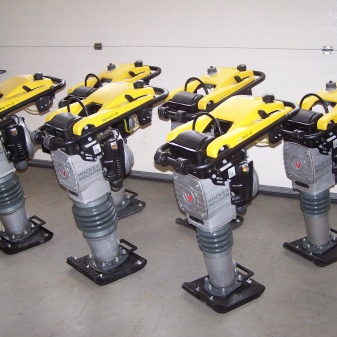
What it is?
The vibratory rammer is a multifunctional manual vibrating machine used in the construction industry to compact bulk materials and loose soils. In appearance, this device is a compact and mobile tool, equipped with manual control.
Tamping the soil using vibration equipment allows you to solve a number of important tasks:
- align and compact the base of the construction site;
- prevent the process of soil shrinkage under the foundation;
- displace moisture and air from the soil structure.


When performing preparatory construction work, a vibratory rammer is used where large-sized vehicles cannot fit due to the limited free space. Hand tools make it possible to tamp in confined openings when laying pipelines, in areas located near walls or corners of buildings, when building bike paths and laying curbs or sidewalk elements. The handheld tool performs its functions efficiently without damaging buildings or utilities.
The complete set of manual vibratory rammer consists of the following main parts:
- an engine that can be gasoline, diesel or electric;
- cam-eccentric type mechanism;
- shaft equipped with a special return spring;
- connecting rod with a special piston;
- sealing sole;
- manual control system



A manual vibratory rammer can also be called a vibro-leg, since the area of the compaction sole of this tool is small and amounts to 50-60 cm². This compactness is needed to reduce the weight of the equipment, but it does not reduce the stability of the tool and makes it possible to develop the vibration force required for work. Despite its compactness, such equipment requires significant physical efforts from the operator associated with the movement of the apparatus and maintaining its stability in an upright position during work.
In addition, the worker has to experience the strongest vibration loads that adversely affect health. The effectiveness of the manual type of vibratory rammer is due to the impact force and their frequency of 1 minute.
The carefully calibrated ratio of the structure of the device and the significant weight of its upper part relative to the lower one allow the vibrating tool to move forward under the influence of gravity, and the operator only needs to direct the movement of the device.


Where is it applied?
A manual vibratory rammer is used to compact the soil to a depth of at least 60-70 cm.This device is capable of compacting not only sandy or soil cover, but also large crushed stone, therefore, the device is used for crushed stone base, for a lawn,for sand for building a foundation or when preparing a site for a backhoe loader.
The vibrofoot can also compact concrete in hard-to-reach areas.


Often a vibratory rammer is used in places where free space is extremely limited or there is a risk of damage to previously equipped communications:
- works on the arrangement of the tram track;
- arrangement of pedestrian zones and sidewalks with tiles, paving stones;
- preparation of the soil surface for the organization of the foundation;
- partial repair of the asphalt pavement;
- installation of underground communications;
- compacting the soil along the walls of the building;
- arrangement of the basement;
- equipment of wells, hatches, poles.
At construction sites, a manual vibratory rammer is used in all cases when large equipment, due to its size, cannot get close to the working area. Manual vibratory rammer is used only for free-flowing fractions - sand, soil, gravel, but is not used for compaction of soil, which contains a large percentage of clay impurities.


Comparison with a vibratory plate
The hand tool, with which you can ram bulk soils, does not only consist of a vibratory rammer. In addition to this device, there is also a vibrating plate. In some cases, it copes better with the assigned task, since the area of its tamping sole is twice as large as that of a vibro-leg.
In appearance, the vibrating plate has a base-platform on which the vibration unit, a motor, a general structural frame and a control system panel are based. With the help of this device, loose substances are tamped in small areas. Some models of vibrating plates have a reservoir for water in their design, which wets the rammed surface, improving the density of free-flowing fractions. The ramming depth of the vibratory plate is less than that of the vibro-foot, and is 30-50 cm, but due to the larger area of the working sole, the productivity of the vibratory plate is much higher.
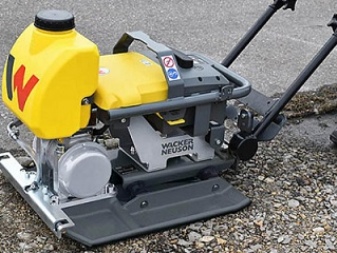

Vibratory rammer and vibratory plate have common applications for soil compaction. But there are also differences between these devices. Structurally, the vibrating plate is designed so that vibration appears in it due to a special mechanism - an eccentric, fixed in the ramming plate. The mechanism is powered by the engine, and the vibrations are transmitted to the plate. The manual vibratory rammer is arranged differently, since the energy generated from the motor is converted into push-and-forward movements. The connecting rod piston pushes the vibration sole, and at this time, an impact is created in relation to the ground. The impact force of a vibratory rammer is much greater than that of a vibratory plate, but the processed area is less.
Although both hand tools are designed for ramming, their purpose is also different from each other. The vibratory rammer is not used on clay soils and is not used for paving asphalt, while the vibratory plate is suitable for these tasks.
The vibratory rammer will prove to be an ineffective tool if used on large surfaces; it is used only locally in a limited space.


Species overview
Manual ramming is performed with a tool, the device of which can be stationary or reversible. The reversible vibratory rammer operates in two modes of action - forward and reverse, that is, the vibrating tool can move in reverse. A mounted hydraulic vibratory rammer is also widespread, the principle of operation of which allows it to be used in any position and to get close to the most inaccessible places. Usually it is attached to construction equipment, for example, to an excavator, while the width of such a device is greater than that of the manual version, and working with such equipment, the maximum depth of soil processing is achieved.
The characteristics of manual vibratory rammers are divided into 2 types - devices with a low vibration frequency and tools with a large amplitude. Low-frequency equipment is used to perform work only with loose types of soil. Equipment with a large vibration amplitude is used for mixed types of soil compositions and compaction of asphalt concrete mixtures. All manual vibratory rammers are also subdivided according to the type of engine.


Electrical
They are an environmentally friendly type of equipment, since when they are used, no harmful gases are emitted and no noise is produced, therefore such a tool can be used even in closed rooms. The tool is powered from a conventional power supply; the devices are generally easy to use and manage.
This type of tool is in low demand, since being tied to a power source makes it immobile and low-maneuverable, and the need to use such equipment in rooms does not often arise.


Diesel
They have low consumption of diesel fuel, but have a long working life and good maneuverability. They are used for outdoor street work, have a high vibration impact force and high productivity. With this tool, you can work in any weather conditions - in snow and rain.
The tool generates a high intensity noise during operation, therefore the operator will need to use protective equipment. In addition, such vibratory rammers emit exhaust gases, which negatively affects the health of the worker and does not allow using the equipment in closed rooms.


Gasoline
The tool is powered by a 2- or 4-stroke engine. It is powerful and mobile equipment with great performance. The vibratory rammer can work in all weather conditions. Like its diesel counterpart, the tool generates exhaust fumes and cannot be used indoors.
Modern hand-type vibratory rammers free a person from exhausting and monotonous work that requires a lot of time and effort.
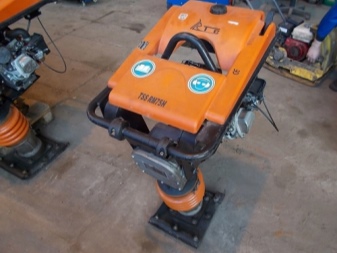
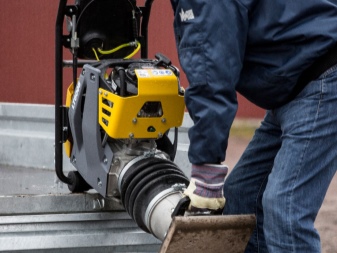
Popular models
Hand-held vibratory rammers are produced by both domestic and foreign manufacturers. The equipment is diverse in its design and price range.
Top of the most famous options for vibrating tools.
- Model Hundai HTR-140 - a high-quality tool with which a loose or solid type of soil is processed. Able to work with a vibration shock force equal to 14 kN, their frequency is equal to 680 beats / min. Starting the engine is quick and easy, aided by an overhead valve cylinder system. The frame design is equipped with spring-type shock absorbers. The tool is capable of withstanding significant loads and has proven itself in tough applications.

- Model EMR-70H - can be used for compacting viscous loamy soils. The unit is powered by a high quality Honda 4-stroke engine. The design of the vibro-leg is made in such a way that inspection of all units can be performed promptly. The engine is protected by a frame. The tool is equipped with a plastic tank, and the handle is equipped with anti-vibration protection made of silent blocks.

- Model AGT CV-65H - the device has a working sole of 285x345 mm, the vibration force is 10 kN, the vibration frequency is 650 bpm. The design includes a Honda 4-stroke gasoline engine with a power of 3 liters. with. This is a compact and maneuverable vibro-leg, which is often purchased for domestic needs by summer residents and residents of private houses. The device is capable of compacting the soil to a depth of at least 60 cm, so it can also be used in the construction and road sectors.
The use of a compact vibro-leg makes it possible to quickly and with minimal economic costs prepare the soil surface for further construction or road works.
Equipment of this type compresses well not only the upper, but also deep layers of the soil.

How to choose?
A manual vibratory rammer, like any other tool, requires a careful approach when choosing. Most often, the buyer is interested in the size of the working sole, the quality of the engine, grip, brake pads. As a rule, modern equipment has a long working life and a warranty period of service.
So that the chosen vibro-leg does not disappoint and can work in the conditions necessary for you, experts recommend paying attention to criteria such as:
- working power of the motor;
- sole area;
- vibration frequency and strength;
- depth of soil processing;
- fuel or electricity consumption;
- the presence of an anti-vibration protective system on the tool handle.
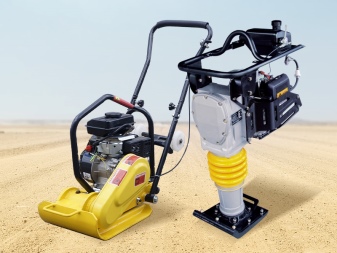

Particular attention should be paid to engine power, the average values of which vary from 2.5 to 4 liters. with. The more powerful the motor, the more efficient the equipment and its impact force. The area of the working sole is selected based on the conditions in which you have to work - if the free space is very limited, it makes no sense to choose a tool with a large area of the sole.
The frequency of the shock vibration determines the speed of work, so the higher the rate, the faster you will complete the task of compacting the soil. The maximum impact rate does not exceed 690 beats / min, and the impact force rarely exceeds 8 kN. An important parameter is the maneuverability and weight of the tool. The lighter the manual vibratory rammer is by weight, the easier it is for the operator to operate it. The weight of the equipment varies from 65 to 110 kg, so when choosing a model, you should evaluate your strengths and capabilities.


Operating tips
As a rule, the manufacturer indicates in the technical documentation for the manual vibratory rammer the useful life of the device equal to 3 years. During this time, it is necessary to carry out preventive inspections - to fill the engine with oil in a timely manner, change the brake linings and carry out maintenance of the clutch, if necessary - change the connecting rod, and so on.
Equipment that meets technical standards is capable of compacting the soil to the depth indicated in the data sheet. But at the same time, it is recommended to monitor the level of fuel consumption - on average, fuel consumption should not exceed 1.5-2 l / h.
When working with the vibrator, it is recommended to use the vibration protection system located on the handles of the tool and use personal protective equipment for the hands.


In the next video, you will find a detailed review, advantages and test of the Vektor VRG-80 gasoline vibration rammer.









If the clay is mixed with crushed stone, it will be much stronger.
The comment was sent successfully.